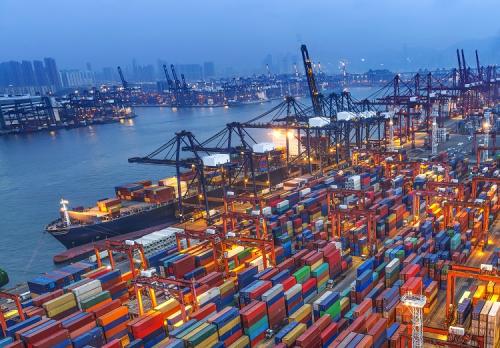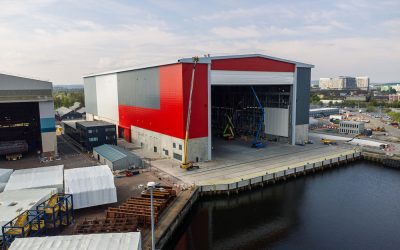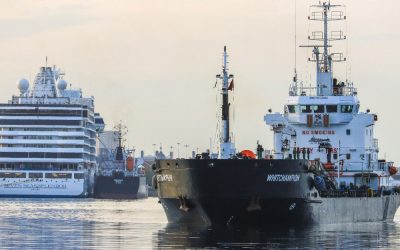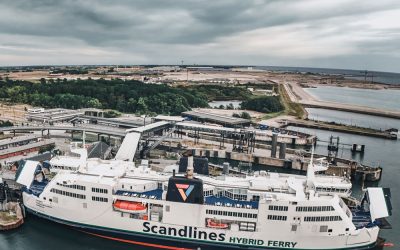While the Covid era brought huge changes to many of our lives, for the container ship sector it very quickly turned into a boom cycle that continues to show little sign of slowing down, at least not yet. Despite concerns when the pandemic first struck that demand for goods would slump and freight rates likewise, Chinese production very quickly returned to normal and, coupled with government stimulus packages and an abundance of housebound consumers keen to splash out, conditions for container operators were suddenly very favourable.
However, these once-in-a-century circumstances also put the logistics infrastructure under an impossible strain, leading to congestion that’s still being felt today and unlikely to abate until next year.
“There’s enough ships but the problems are staff shortages at ports, trucks, railroads, warehouses. Every aspect of the supply chain was basically stripped of capacity,” Simon Heaney, senior manager for container research at maritime markets consultancy Drewry, tells The Naval Architect. “The mismatch means ships are waiting weeks on end for a berth, because the ports can’t clear containers quick enough, so everything is elongated. Without Covid there were enough ships and equipment but it couldn’t handle the snafus on the supply chain.”
“You can’t build a supply chain that can weather that sort of surge. If there was a miracle way of doing it the investment would be astronomical and the returns zero, because outside these events the market would be hugely oversupplied.”
What these delays have done is driven an appetite for container ship tonnage that’s almost unprecedented. According to Drewry’s own data, up to 1 April 2022 there had been orders for 864 vessels due for delivery between now and 2025, accounting for just under 6.6 million TEU, or 26.4% of the current container fleet’s capacity. Vessel scrappings, meanwhile, have reached zero and it’s well publicised that there have even been instances of bulk carriers being repurposed for container shipping.
Supply chain fragility
If Covid represented the perfect storm for challenging container logistics then the situation with Ever Given, the 20,124 TEU boxship that became grounded in the Suez Canal in March last year, was at least a salutary reminder of the supply chain’s fragility. It’s estimated that around US$60 billion of trade was held up during the week-long incident, but Heaney is doubtful anything much will change as a result.
Heaney comments: “From memory the last incident like this was 20 years ago, the difference this time was it was one of the world’s biggest container ships and the time it took to get cleared, but the risk is always there… [Ever Given] was another contributing factor in the increase in freight rates, so in effect operators actually gained from it.”
The practice of capacity management, by which operators deliberately remove vessels from service to stimulate the market, is essential to maintaining healthy freight rates. During the 2008-2009 financial crisis around 10% of the container fleet was kept in anchorage for months on end, but in the current situation it’s more a case of managing port congestion and has led to freight rates at exceptional levels.
Drewry’s analysis suggests this bull run is now coming to an end, although port bottlenecks are expected to continue into 2023. However, forecasting is far from scientific and largely dependent on anecdotal evidence and surveys. While the expectation is that the economy will remain broadly in growth there’s every possibility demand could fall rapidly in the event o a major recession.
By their nature such trade cycles are insidious. The newbuilding orders that cash-rich owners are currently placing – often without long-term charters – won’t translate into in-service vessels for another two years, by which point it’s widely anticipated that, coupled with inflation escalating globally, there will be a global recession. Any demand slump will inevitably lead to excess tonnage, but likely most owners would sooner hedge their bets than request costly cancellations. When one then considers other factors in this ‘polycrisis’ such as climate change, US-China trade tensions and the sanctions imposed upon Russia following the invasion of Ukraine, it’s unsurprising that most container operators expect their salad days are coming to an end.
Smaller vessels?
A noticeable trend of the current orderbook, Heaney notes, is that owners are opting for slightly smaller vessels than the 20,000TEU plus mega ships. The world’s current largest container ship, by capacity Evergreen’s 24,004TEU Ever Alot, delivered earlier this year, and while an as-yet-unnamed 24,232TEU MSC vessel should take that record in 2023, Heaney doesn’t expect the size to increase much further in the foreseeable future.
While such ships do offer economies of scale there are obvious disadvantages in terms of where the ships can be deployed, since only the largest ports can accommodate them and the protracted time it takes to unload such large numbers of boxes. On aggregate, the largest number of vessels (222) due for delivery between now and 2025 are the so-called Maxi neo-Panamax (vessels with a beam of around 48-51m, with capacity of 12,500-18,000TEU).
With scrapping rates flatlining, the question arises whether older vessels might risk undermining efforts to reduce carbon emissions in the fleet, although Heaney says many of the most aged vessels tend to be at the smaller end of the scale.
Heaney comments: “Obviously there are new regulations coming into effect from 1 January next year – namely EEXI and Carbon Intensity Index (CII) – but we’ve done some analysis and found that very few ships won’t be compliant with EEXI. That’s partly because most container ships are already operating well below design speed, which has been the case for well over a decade now. We identified two classes, basically the very small feeders, of which there were perhaps 1,000-1,200 ships which might be slightly afoul of the regulations, but they would only need to slow down a touch to be acceptable.
“If those vessels had been scrapped [freight rates] would be even higher, but we’ve identified about 400,000TEU that we expect to see demolished from next year onwards to meet equity rules. CII won’t be measured until the end of the year when they calculate the average speed and how much cargo they’ve moved. The older ships that are less likely to pass those carbon intensity rules will disappear first and as the market changes and earnings potential diminishes, as we expect to happen, then the incentive to scrap increases.”
Greener ships
Like other sectors, container ships are gradually transitioning towards greener fuels, with Drewry’s data indicating that as of the end of June 54% (approx. about 750,000TEU) of vessels ordered this year will run primarily on alternative fuels, with LNG inevitably being the dominant choice. Although it’s not something that Drewry actively projects for outside of bespoke Heaney says this is in line with expectations and should eventually reach 100%. Although such vessels demand greater capex it’s further incentivised by the rising price of traditional fuels. Moreover, since many of the largest customers are public-facing companies keen to promote their green credentials, there is pressure coming above and beyond regulatory requirements.
In recent years there has been significant speculation that advances in manufacturing technology, such as 3D printing, could lead to radical changes to the supply chain, with the possibility that consumer goods could be produced much closer to their intended market, but Heaney says there’s little evidence of any changes in the foreseeable future.
“In terms of hard numbers China is still the dominant player. Everybody wants a bit more resilience in the container sector but how to go about it? They’re just responding to what the market wants. If it was decided all of a sudden that European goods were going to be produced in Turkey that would clearly be a problem for liner shipping because they’ve invested heavily in big ships, then all of a sudden it would be much smaller ton-mile journeys. But we’ve not seen any evidence of it.”






